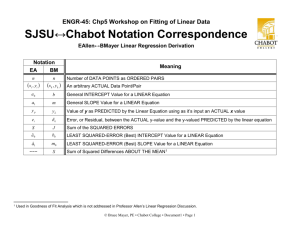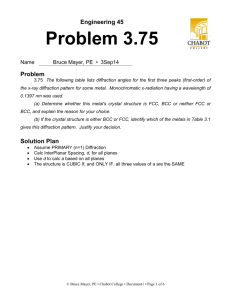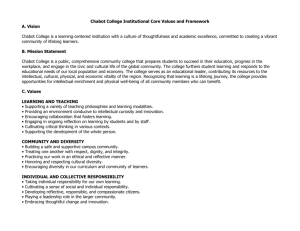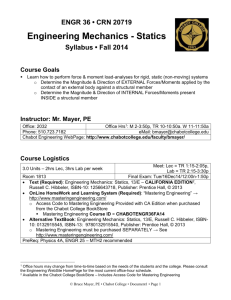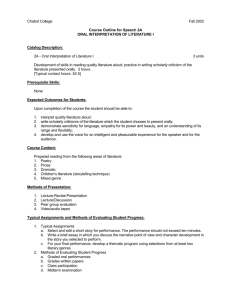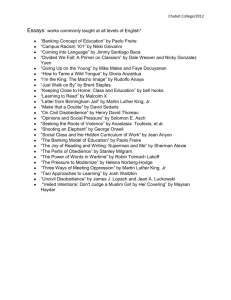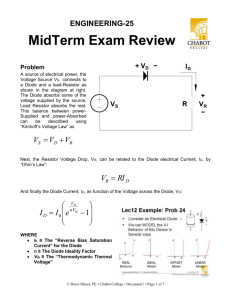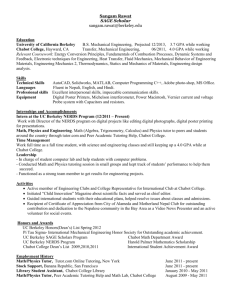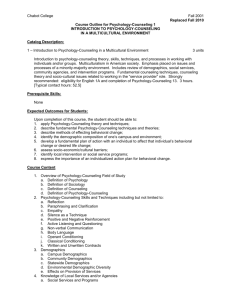Syllabus - Chabot College
advertisement
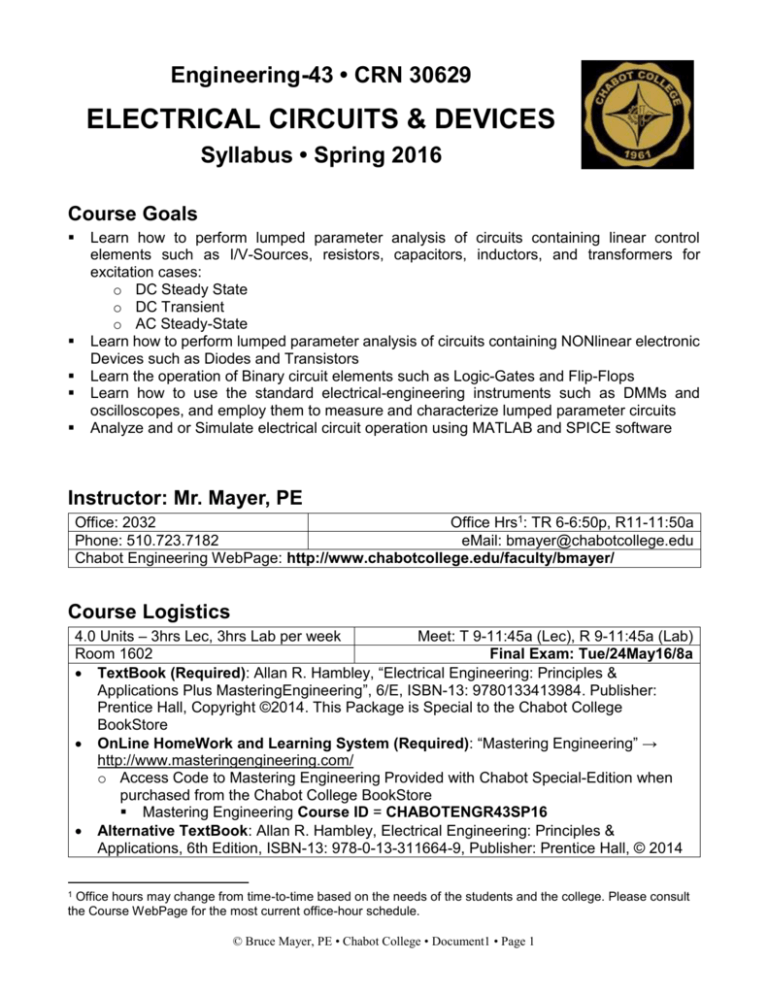
Engineering-43 • CRN 30629 ELECTRICAL CIRCUITS & DEVICES Syllabus • Spring 2016 Course Goals Learn how to perform lumped parameter analysis of circuits containing linear control elements such as I/V-Sources, resistors, capacitors, inductors, and transformers for excitation cases: o DC Steady State o DC Transient o AC Steady-State Learn how to perform lumped parameter analysis of circuits containing NONlinear electronic Devices such as Diodes and Transistors Learn the operation of Binary circuit elements such as Logic-Gates and Flip-Flops Learn how to use the standard electrical-engineering instruments such as DMMs and oscilloscopes, and employ them to measure and characterize lumped parameter circuits Analyze and or Simulate electrical circuit operation using MATLAB and SPICE software Instructor: Mr. Mayer, PE Office: 2032 Office Hrs1: TR 6-6:50p, R11-11:50a Phone: 510.723.7182 eMail: bmayer@chabotcollege.edu Chabot Engineering WebPage: http://www.chabotcollege.edu/faculty/bmayer/ Course Logistics 4.0 Units – 3hrs Lec, 3hrs Lab per week Meet: T 9-11:45a (Lec), R 9-11:45a (Lab) Room 1602 Final Exam: Tue/24May16/8a TextBook (Required): Allan R. Hambley, “Electrical Engineering: Principles & Applications Plus MasteringEngineering”, 6/E, ISBN-13: 9780133413984. Publisher: Prentice Hall, Copyright ©2014. This Package is Special to the Chabot College BookStore OnLine HomeWork and Learning System (Required): “Mastering Engineering” → http://www.masteringengineering.com/ o Access Code to Mastering Engineering Provided with Chabot Special-Edition when purchased from the Chabot College BookStore Mastering Engineering Course ID = CHABOTENGR43SP16 Alternative TextBook: Allan R. Hambley, Electrical Engineering: Principles & Applications, 6th Edition, ISBN-13: 978-0-13-311664-9, Publisher: Prentice Hall, © 2014 1 Office hours may change from time-to-time based on the needs of the students and the college. Please consult the Course WebPage for the most current office-hour schedule. © Bruce Mayer, PE • Chabot College • Document1 • Page 1 Mastering Engineering must be purchased SEPARATELY → See http://www.mypearsonstore.com/bookstore/masteringengineering-instant-access-forelectrical-0133405591 Software Access: o MATLAB Math-Processing Software- Available in o Rm 1804 Computer lab during ENGR25 Hours o STEM Center, Rm 3906, During Center Operating hours PSPICE Circuit-Simulation Software o FREE DownLoad http://www.eng.auburn.edu/ece/download/91pspstu.exe MSWord Word-Processing & MSExcel Number-Processing Software PreReqs: Physics 4A, Engineering 25 Recommended: Physics 4B (concurrent enrollment is optimum) Grading Weight Function Labs Practical Lab Exam M.E. HW Assignments HW Journals MiniQuizzes MidTerm Exam-1 MidTerm Exam-2 Final Exam 10% 10% 10% 3% 4% 20% 21% 22% Grade Assignment 90%-100% 80%-89.99% 70%-79.99% 60%-69.99% <60% A- to A+ B- to B+ C- to C+ D- to D+ F The instructor reserves the prerogative to adjust the location and/or width of the GradeAssignment bands based solely on his professional judgment of overall class performance. NOTE: Keep ALL your GRADED work until AFTER you have received your final grade. This grading record will help to substantiate any grade-recording errors committed by the instructor2. General Expectations 2 The Instructor’s ErrorRate is good, perhaps about 0.2%, but it is NOT zero © Bruce Mayer, PE • Chabot College • Document1 • Page 2 In ENGR-36, ENGR-43, and ENGR-45 the Engineering Instructors expect each student to exhibit demeanor, comportment, and sense of responsibility consistent with those of a practicing engineer. Doing Well In This Course This Course is PROFESSIONALLY important. EVERY Engineer should be able to understand basic electrical circuits, and measure (at a minimum) Potential, Current, and Continuity using the DMM. To best learn the course material: 1. EXPLOIT The TextBook Do not merely read the text; WORK the text o Obtain the TextBook IMMEDIATELY and start USING IT o BEFORE attempting the HomeWork assignment, go thru the chapter with a PENCIL & PAPER. Work the EXAMPLE problems until you can solve them without referring to the text solution 2. LISTEN to the Instructor A second point of view that differs from the TextBook aids understanding What the instructor covers in his/her OWN WORDS usually ends up on Exams 3. GET YOUR HANDS DIRTY in the Lab Do NOT be PASSIVE in the LAB. Use the Hardware with your OWN HANDS o ENGR43 uses safe levels of Electrical Potential (voltage), and the equipment is selfprotecting (for the most part) so don’t worry about making honest mistakes Worry MUCH MORE about NOT learning how to use the components and instruments 4. Think PHYSICALLY This is NOT a MATH class; rather it’s an engineering class that uses sophisticated mathematics to analyze the operation of physical electrical devices and systems. o Try to understand the circuit operation in terms of energy (voltage or “potential”), conservation (current or charge or “flow”), and power ([potential]×[flow], and not just in terms of abstract symbols. 5. Use UNITS to the maximum possible extent. Units connect an Engineer’s thinking to the Real, Physical World 6. DRAW LOTS of DIAGRAMS When analyzing a circuit REDRAW it OFTEN; sometimes after EVERY analytical step Sometimes just “UnTangling” a circuit drawing can reduce the solution-difficulty by 90%. Use MATLAB or EXCEL to graph data or analytical Solutions. Recall the Instructors Advice from ENGR25 o When in Doubt GRAPH it. If you don’t know when to doubt, GRAPH it ANYWAY 7. PUT IN the TIME A serious engineering student will spend 8-10 hours per week OUTside of class studying the course-material and/or preparing Lab Reports Stay on the assignment schedule to avoid “Rush Jobs” that produce MINIMAL learning, and to avoid Late Penalties 8. ASSIST your COLLEAGUES © Bruce Mayer, PE • Chabot College • Document1 • Page 3 One of the best ways to LEARN something is to TEACH it to someone else. o If a ClassMate seeks your assistance with the HomeWork or in the Lab, do your best to accommodate him/her with a careful explanation HomeWork Problem Count, ENGR43 • Sp16 30 • 256 Problems, Total • Not Shown: 19 EC probs 26 25 22 Number of Problems 20 20 19 18 17 17 15 15 14 14 13 12 10 12 9 9 8 HomeWork 8 5 1. All HomeWork Problems will be HomeWork Assignment Number accomplished on the Mastering HomeWork Point Count, ENGR43 • Sp16 Engineering OnLine HomeWork & Learning-System as described in the “Course Logistics” section of this syllabus. Figure 1 contains a HomeWork assignment summary. Table 1 displays the relative point-importance of each HW assignment. MATLAB SYMBOLIC calculations may be performed using MuPAD as an alternative to the older MATLAB “symbolic math” HomeWork Assignment Number commands. The old system can usually be identified by the use of Figure 1 • ENGR43 Mastering Engineering a declarative command similar to: HomeWork Summary. Top → Number of syms x y PROBLEMS per assignment. BOTTOM → 2. Do not miss Classes or Labs; if you miss Number of POINTS per assignment a session you are responsible for obtaining any class material through consultations with your colleagues (class-mates), or in some cases through accessing the course WebPage 3. If you have difficulty with any aspect of the HomeWork; follow this escalation procedure Try again yourself, consulting reference books, websites, etc., if practical. Use the Mastering Engineering “Hints” feature Consult with your colleagues (remember, they have their own work to do) Consult with the instructor. But be aware that in Professional Engineering Practice you HAVE NO INSTRUCTOR that knows the answer. 4. Find in Figure 2 The Mastering Engineering LATE Fee Discount algorithm 0 1 2 3 4 5 6 SP 7 8 9 10 11 12 13 14 15 16 SLO_Col_Charts_1101.xls 500 • 3980 Points, Total • Not Shown: 209 EC pts 461 450 405 Number of Problems 400 350 314 314 301 300 294 283 279 250 232 215 200 191 182 162 150 135 100 50 94 84 34 0 1 2 3 4 5 6 SP 7 8 9 10 11 12 13 SLO_Col_Charts_1101.xls HOMEWORK JOURNALS Since the Exams in this class are done, in VAST MAJORITY, by HAND, students are required to do the HomeWork by HAND. While working the Mastering HomeWork assignments students should work the problems on paper, and then Figure 2 • ENGR43 Mastering Engineering Late HomeWork Penalty-Algorithm © Bruce Mayer, PE • Chabot College • Document1 • Page 4 14 15 16 enter the answers into Mastering Engineering. Table 1 • Relative Weights of HW Assignments Students will collect this HandWork in an inexpensive binder that will then constitute a HW Assignment Pt Weight HomeWork Journal (HWJ). Students will turn-in HW-01: Intro to Mastering 0.88% the HWJ’s on the Due Dates noted on the HW-02: Chp01 8.17% schedule. To receive full credit for the HWJ, a HW-03: Chp02-1 4.73% student must: HW-04: Chp02-2 11.99% show all his/her work (no work no credit) HW-05: Chp03 7.83% be neat; If it can’t be read, it can’t be HW-06: Chp04-1 7.26% understood or graded HW-07: Chp04-2 5.59% start each Assignment on a new page HW-08: Chp05-1 10.53% with the chapter and assignment HW-09: Chp05-2 6.03% number in the upper right hand corner HW-10: Chp06-1 7.36% put assignments in chronological order HW-11: Chp06-2 2.18% based on the date of the assignment; the HW-12: Chp07-1 4.21% oldest assignment first securely fasten all assignments in a HW-13: Chp07-2 2.44% folder (NOT a binder) similar to that HW14: Chp10 8.17% shown in Figure 3 to form the Homework HW15: Chp12 4.97% Package as indicated in the schedule. HW16: Chp14 7.65% o The FIRST page on the inside of the folder must be the ENGR-43 HomeWork Package Cover Sheet (Figure 3 right photo) Copies of the CoverSheet will be provided before HWJ-1 is due The HWJ CoverSheet MSWord File may Also be DownLoaded from the Course WebPage – search word “cover” o The student name must be visible with the folder closed o turn in all the assignments for the HomeWork Journal as noted in the schedule © Bruce Mayer, PE • Chabot College • Document1 • Page 5 Figure 3 • Homework-Journal folder. The Cover Sheet (right) must be the first Page. The folder must BIND the stapled Homework Assignments. Note use Binding FOLDERS ONLY; please do not submit ThreeRing Binders. How to Study Like a College Student - EXTRA CREDIT Students can earn EXTRA Credit in the approximate amount of 2% of the Total HomeWork Points for completing the Take Home Quiz based on the College Student Study Skills presentation. The Presentation may be found on the Course WebPage The Take Home Quiz (THQ) is due as noted on the schedule o NO Late THQs accepted Supplies and Equipment Required Scientific Calculator (NO CellPhone calculators allowed on Exams) o POLAR COORDINATES capability strongly recommended Engineering Computation Pad, 8.5” x 11”, Green Background, 0.2” Grid Access to MATLAB Software & Printer; e.g.3, During ENGR25 Lab Periods in the ENGR25 Lab-Room listed on ClassWeb or in the STEM4 Center in room 3906. Recommended 0.5 mm, Quality Mechanical Pencil Quality Straight-Edge Ruler Access to MicroSoft Excel Others As Announced by the Instructor during the Course of the Semester “e.g.” is an abbreviation for the Latin Phrase “exempli gratis” which translates literally to “Free Example” and more commonly translates to “For Example” 4 Science, Technology, Engineering, and Mathematics 3 © Bruce Mayer, PE • Chabot College • Document1 • Page 6 Attendance Grade-Performance in this course correlates strongly with class attendance; students who attend class sessions statistically receive better grades than students who miss lecture and/or laboratory sessions. The KEY to meeting the course goals is CONSISTENCY; Come to class EVERY time, complete EVERY HomeWork and Lab assignment ON-TIME. A Student will be dropped from the class if he/she misses two, or more, class periods during the first Three weeks of the term. Coming-Late or Leaving-Early should be RARE events. If a student needs to arrive late or leave early, please find a seat near the door. Please enter or leave quietly, so as to not disturb the rest of the class. Instructors consider a student walking between the instructor and the class to be a very inconsiderate and discourteous act. MiniQuizzes 35-45, single-problem “MiniQuizzes” will be administered during the course of the term. The MiniQuizzes (or MQs) will be “pop” in nature; that is, the MQs are not announced in advance. Some details on the MQs: MQs may be administered at ANY time during the o LECTURE class period o Circuits LAB period Some Class Meetings will have NO MQ Some Class Meetings will have MORE THAN ONE MQ MQ content typically consists of subject matter covered during the previous class meeting o Content may be drawn from either the Lecture or TextBook or LabExercises MQ Duration shall be 5 minutes. MQs will be collected promptly after the 5 minute duration; NO extra time will be allowed for any reason. There will be NO MakeUp MQs for any reason MQ’s will NOT be Returned o Students are welcome to take unused copies of any MQ for subsequent ReWork MQ scoring: o 0 Points → Student does not take the MQ o 1 Point → Student takes the MQ, but shows NO, or LITTLE, evidence that the student gave his/her full attention to the previous lecture(s). o 2 Points → Student takes the MQ and shows SUBSTANIAL evidence that the student gave his/her full attention to the previous lecture(s). The answer need NOT be CORRECT; however, the answer must show serious effort & understanding against the problem or question posed. o 3 Points → Student takes the MQ and produces the Correct Answer, an incorrect Answer resulting from a simple “BookKeeping” blunder © Bruce Mayer, PE • Chabot College • Document1 • Page 7 Written Exams This course covers a large number of analytical techniques. The goal for the course is proper application of these tools, not necessarily to recall every detail5 about the tools themselves All exams are OPEN TEXT-BOOK o Students may bring to the exam these, and ONLY these, reference materials The required course text book; Hambley (see “Course Logistics”) A single, 8.5”x11” reference sheet prepared by the student (Both Sides, OK) o This “SRS” MUST be HAND-WRITTEN; No PrintOuts or PhotoCopies permitted ASSIGNED SEATING for all exams. o On Exam Days the instructor will place the exams on the desks, FACE DOWN, with a student name written on the back of the Exam. Each Student is requested to find the exam with his/her name on it and take that seat withOUT turning over the exam until notified by the instructor. Turning over the exam early will be regarded as an act of Academic DIShonesty Taking a seat other than that assigned will also be regarded as an act of Severe Academic DIShonesty All students are requested to be ON TIME on Exam Days MakeUp exams are only offered in those cases where the student can provide 3 rd party justification (e.g., note from a medical doctor) for the absence. o Any MakeUp exam must be taken the NEXT day, at a time & location determined by the instructor. o All MakeUp exams are subject to a 15% score-penalty. MakeUp exam takers have extra study time, and may learn about the exam content prior to the MakeUp. This is simply NOT FAIR to those students who make the (sometimes extraordinary) effort to come to the exam on-time. Use of material other than the approved textbook and the student reference sheet shall be considered a serious case of ACADEMIC DISHONESTY Homework Journal Entries Format Homework will be ANALYTICAL in nature. Students solve (usually) well posed problems using paper, pencil, calculator, and (in some cases) MATLAB, MuPAD, or SPICE software. The results of the HandWork will then be entered in the Master Engineering Computer-Based HomeWork System Student must SHOW THE STEPS that lead to the solution o For any MATLAB problems attach both the Source Code (Command-Session or M-File Text) The Solution Output; typically Number(s) or Plot(s) o The HomeWork presentation for SPICE software will be described separately 5 Although ReCalling the Tool-Details is VERY GOOD for an Engineer © Bruce Mayer, PE • Chabot College • Document1 • Page 8 Neatness Counts Most University Engineering Professors Expect a Polished Homework Presentation Production of Computer-Generated CHARTS, GRAPHS, TABLES, etc. is encouraged o All Charts, Graphs and Tables should be properly Formatted and Labeled as described in ENGR25 More readable work helps the grader Homework assignments Homework Assign/Due Dates are as noted on the course Schedule Homework Presentation: Submit all homework on 8.5” x 11” paper. If more than one sheet, staple in the upper left corner. Boxing It For all hand Calculations, Identify your final answer by For any computer calculation, identify your answer by BOLDING IT Present all work professionally: organized, logical, neat, legible, complete On the top of the homework assignment the following MUST appear: o Your Name o The Course Number ENGR 43 o The Date Upon Which you COMPLETED the work o Assignment No. ______ (e.g. HW-07) Homework Due Date & Time as Noted in Mastering Engineering Note that Missing deadlines or milestone-dates in Engineering-Pracitce, and at Universities is generally regarded as unprofessional performance CourseWork Collaboration Working in groups on the homework is fully acceptable. However, each student must turn in his/her OWN homework Journal Laboratory Work ENGR43 is extremely fortunate to have Mr. Wayne Phillips from the Chabot College Electrical Systems Technology (ESYS) program serving as the Laboratory-Instructor for this Course. Mr. Phillips Syllabus for the Lab Portion of ENGR43 can be DownLoaded from the ENGR43 WebPage Mr. Phillips will separately describe the Lab-Exercise operations and protocols Practical Laboratory Examination Each student is expected to become proficient the operation and use of the electrical-circuits laboratory equipment. To test each student’s lab knowledge and skills a practical, hands-on examination shall be administered as determined by Mr. Phillips. Mr. Phillips will separately describe the Lab Exam Protocol © Bruce Mayer, PE • Chabot College • Document1 • Page 9 Withdrawal From Course From the Chabot College WebSite6 Dropping Classes Students are responsible for dropping or withdrawing from classes. Failure to follow the withdrawal procedures may result in a grade of "F". Students who drop before the No Grade of Record (NGR) period will not have a grade appear on their transcript. After the No Grade of Record, or “NGR”, date any student wishing to withdraw from the course to receive a “W” on his/her grade-transcript MUST, to completely avoid an “F” grade, initiate the withdrawal through the Admissions & Records process. In other words, to ensure an F-free transcript the STUDENT must drop the course either using CLASS-Web, or in-person in Bldg700. Do NOT ASSUME that the instructor will drop any student from the course The instructor MAY drop students from the course at the “Last day to drop with a ‘W’ (Withdraw) as indicated in the “Academic Calendar” published in the Chabot College class schedule. The “W-Date” is typically about 70% of the way thru the term. Student actions leading to an instructordrop include EITHER of Not ATTENDING class for 3 weeks prior to the W-Date Not turning in HOMEWORK and/or LABS for 3 weeks prior to the W-Date Not taking a MIDTERM EXAM WARNING: After the “W date” the Instructor is OBLIGATED by College Policy to give all enrolled students Letter Grades. ONLY Chabot COUNSELING can approve “Late W’s”. ClassRoom Courtesy As a courtesy to other students and the instructor in any classroom: 1. When coming-late or leaving-early, PLEASE do NOT walk in FRONT of the instructor while he/she is speaking Please take a seat as UNOBSTRUSIVELY as possible. o The goal for coming-late or leaving-early students is that NO ONE notices the entrance or exit. 2. PLEASE do NOT activate any PRINTERS (or other noise-making objects) during lectures or discussions 3. PLEASE do NOT Type/KeyBoard during lectures or discussions 4. PLEASE do NOT hold side-conversations during lectures or discussions 5. PLEASE set all CELL PHONES to VIBRATE before entering the classroom 6. PLEASE do NOT bring LIQUIDS into Computer Labs 7. PLEASE DO ask QUESTIONS about the course content 6 See: http://www.chabotcollege.edu/admissions/registration/add_drop.asp © Bruce Mayer, PE • Chabot College • Document1 • Page 10 eMail Communication → SpamFilter Avoidance = “ENGR43” On ALL eMail communication students should please include the text “ENGR43” in the subject line. Otherwise the student eMail may be sent to the college SpamFilter folder which is not often inspected by the instructor. Student Conduct - General Everyone in this class, including the instructor, is a mature adult, so Courteous and Respectful behavior is expected at all times. Please and thank you go a long way to make a pleasant atmosphere. Swearing is not appropriate for the classroom (nor in an engineering business environment). Do not talk if another student or the instructor is speaking about course content. Student conduct, and consequences for misconduct, shall follow the policies described in the STUDENT RIGHTS AND RESPONSIBILITIES” section of the Chabot College course catalog. The minimum sanction for misconduct shall be removal of the student from Class for the remainder of the class period Pagers, Cell Phones, Handheld Computers, and Similar Devices: Must be set to a NONAUDIBLE Condition. After one warning, subsequent violations shall result in a grade sanction equivalent to a missed Homework assignment VISITORS: Note that College policy does NOT allow visitors in the classroom. EATING: This classroom is also an Engineering Laboratory with sensitive equipment that might be damaged by spilled food or drink. Please eat all food outside the classroom. BE PREPARED: Bring paper, your book, and extra pencils or pens. Sharpen your pencils before the class starts. Take care of your personal needs before class starts. PICK UP AFTER YOURSELF: Put all trash in the waste paper basket. Check your desk area before departing to ensure that you have not left any personal items. If you are working in groups, please return your desk to its original position. Institutionally Required Student Conduct “All students are responsible for complying with college and district regulations and for meeting the appropriate college requirements. The College has an obligation to maintain conditions under which the work of the college can go forward freely, in accordance with the highest standards of quality, institutional integrity and freedom of expression. In joining the academic community, the student enjoys the right of freedom to learn and shares responsibility in © Bruce Mayer, PE • Chabot College • Document1 • Page 11 exercising that freedom. Therefore, a student is expected to conduct himself or herself in accordance with standards of the college. Please refer to pages 67-71 of the 2014-2016 Chabot College Catalog http://www.chabotcollege.edu/academics/catalog/Catalog2014-16.pdf, or on the Student Services website on student conduct for detailed information on the Standards of Student Conduct expected of all students.”: http://www.chabotcollege.edu/studentservices/student_conduct.asp Academic Dishonesty Academic Dishonesty of Any Kind WILL NOT BE TOLERATED Any act of academic dishonesty Will result in a grade of ZERO (0) for the assignment/task in which the offense occurred May result, at the sole discretion of the instructor, in the assignment of a grade of F for the COURSE May trigger the formal Chabot College Academic Dishonesty discipline process as described in the “STUDENT RIGHTS AND RESPONSIBILITIES” section of the Chabot College course catalog IMPORTANT INFORMATION REGARDING THE SEMESTER CALENDAR AND OTHER RELEVANT STUDENT INFORMATION IS PROVIDED IN THE SCHEDULE OF CLASSES, THE COLLEGE CATALOG, OR THE COLLEGE WEBSITE. © Bruce Mayer, PE • Chabot College • Document1 • Page 12 Access to TextBook Resources The Purchase of a NEW copy of the text book includes an ACCESS CODE for important student support material. See diagram at right. If a student obtains a USED copy of the textbook, then the student can PURCHASE separate access to the support material. Of particular importance is the student SOLUTION MANUAL; a page of which is shown below. © Bruce Mayer, PE • Chabot College • Document1 • Page 13 TextBook Resources → TextBook Companion Site • http://www.pearsonhighered.com/hambley/ Need to LogIn using Access Card at front of TextBook © Bruce Mayer, PE • Chabot College • Document1 • Page 14 Mastering Engineering → Start Here http://www.pearsonmylabandmastering.com/northamerica/masteringengineering/ o “Bundled” with TextBook in Chabot College BookStore © Bruce Mayer, PE • Chabot College • Document1 • Page 15 Book-Independent Access to Mastering Engineering http://www.mypearsonstore.com/bookstore/electrical-engineering-principles-applications-plus-9780133413984 © Bruce Mayer, PE • Chabot College • Document1 • Page 16 Tentative Lecture/Homework Schedule 05-Jan-16 Adjustments Made As-Needed by the Instructor → Check often the Course WebPage: http://www.chabotcollege.edu/faculty/bmayer/ChabotEngineeringCourses/ENGR-43.htm Mr. Phillips will provide a lab syllabus that describes the LAB Schedule Mtg FLX FLX Day T1 T2 Date Reading Assignment Assign Due Notes 19-Jan-16 NO CLASS MEETING - Flex Day 19-Jan-16 NO CLASS MEETING - Flex Day 1 RLb 21-Jan-16 Syllabus, THQ, Adds. Chp1: Intro to Electrical Circuits 2 2 3 4 4 5 6 6 7 T1 T2 RLb T1 T2 RLb T1 T2 RLb 26-Jan-16 26-Jan-16 28-Jan-16 2-Feb-16 2-Feb-16 4-Feb-16 9-Feb-16 9-Feb-16 11-Feb-16 T1 16-Feb-16 9 T2 RLb T1 16-Feb-16 18-Feb-16 23-Feb-16 9 T2 23-Feb-16 10 RLb 25-Feb-16 11 T1 11 12 T2 RLb Chp1: Ckt-Elements, KVL, KCL, Ohm Chp2: S/P Resistances, V & I Dividers, Lab-01 (Mr. Phillips) Chp2: NodeVoltage & MeshCurrent Analyses Chp2: Super-NodeMesh Lab-02 (Mr. Phillips) Chp2: Thevenin & Norton equivalents Chp2: MaxPower Xfer, SrcXform, SuperPosition, Dep-Src's Lab-03 (Mr. Phillips) Chp3: Inductance & Capacitance → current, voltage, energy, power Chp4: Transient Analysis → DC, RL, RC circuits Lab-04 (Mr. Phillips) Chp4: Transient Analysis → RLC Circuits AppD: Computer-Aided Circuit Analysis with SPICE-Based Software Lab-05 (Mr. Phillips) 1-Mar-16 Chp4: Transient Analysis using MATLAB 1-Mar-16 Guest Lecture by Dr. Laurence Nagel - Founder of SPICE 3-Mar-16 Lab-06 (Mr. Phillips) © Bruce Mayer, PE • Chabot College • Document1 • Page 17 THQ, HW-01 HW-02 THQ is PAPER only THQ HW-03 No Late THQ’s HW-01 HW-02 HW-03 HW-04 Not Cvrd §3[7,8] HW-05 HW-06 HW-04 HW-SP HW-07 DownLoad HW-SP HW-05 HW-06 Can use MuPAD for Section 4.9 Confirmed 5Jan16 Mtg Day Date Reading Assignment 13 13 14 T1 T2 RLb 15 T1 15-Mar-16 Chp5: Sinusoids, Phasors, Impedances 15 T2 15-Mar-16 Chp5: AC Circuit Analysis in Frequency (Phasor) Domain 16 17 17 18 HOL HOL HOL 19 19 20 21 Assign 8-Mar-16 Midterm-1 Chp1-4; 2hrs 8-Mar-16 Midterm-1 Chp1-4; 2hrs 10-Mar-16 Lab-07 (Mr. Phillips) RLb T1 T2 RLb T1 T2 RLb T1 T2 RLb T1 17-Mar-16 22-Mar-16 22-Mar-16 24-Mar-16 29-Mar-16 29-Mar-16 31-Mar-16 5-Apr-16 5-Apr-16 7-Apr-16 12-Apr-16 21 T2 12-Apr-16 22 23 23 24 25 25 26 27 27 28 RLb T1 T2 RLb T1 T2 RLb T1 T2 RLb 14-Apr-16 19-Apr-16 19-Apr-16 21-Apr-16 26-Apr-16 26-Apr-16 28-Apr-16 3-May-16 3-May-16 5-May-16 Lab-08 (Mr. Phillips) Chp5: AC Power, AC Thevenin & Norton Chp6: Frequency Response, Lo/Hi Pass Filters, Xfer Function Lab-09 (Mr. Phillips) No Class - Spring Break No Class - Spring Break No Class - Spring Break Chp6: Bode Plot Construction Chp6: 2nd-Order Filters; Bode plots using MATLAB Lab-10 (Mr. Phillips) Chp7: Binary Numbers, Boolean algebra Chp7: Combinatorial Logic ckts → Inverter, AND/NAND, OR/NOR Lab-11 (Mr. Phillips) Chp7: Time Sequential Logic ckts → RS, D, and JK Flip-Flops Chp10: Diode characteristics, Diode ckt Load-Line Analysis Lab-12 (Mr. Phillips) Midterm-2 Chp5-7; 2hrs Midterm-2 Chp5-7; 2hrs Lab-13 (Mr. Phillips) Chp10: Diode Rectifier Circuits Chp12: NMOS & PMOS Field Effect Transistor Characteristics Lab-14 (Mr. Phillips) © Bruce Mayer, PE • Chabot College • Document1 • Page 18 Due Notes HW-07 HW-08 HW-SP HW-09 HW-10 HWJ-1 HW-SP is PAPER only NOT Covered: Sec-5.9 (3𝜙 ckts) HWJ-1 = 1→7 HW-08 HW-09 HW-11 W-Day = 17Apr15 HW-12 HW-10 HW-11 HW-13 HW-14 HW-15 HW-12 Not Covered §10.7 HW-13 HWJ-2 HWJ-2 = 8→13 Mtg Day Date Reading Assignment 29 29 30 31 31 32 T1 T2 RLb T1 T2 RLb 10-May-16 10-May-16 12-May-16 17-May-16 17-May-16 19-May-16 33 Tue 24-May-16 Final Exam 8-9:50am Chp12: Large & Small signal NMOS & PMOS FET Amplifiers Chp12: CMOS Logic Gates →' Architecture, Timing, Power Lab-15 (Mr. Phillips) Chp14: Operational Amplifiers Characteristics, Ideal OpAmp Chp14: OpAmp Ckts: inverting, noninverting, integrators, etc. Lab-16 (Mr. Phillips) Assign Due Notes HW-14 HW-16 HW-15 HW-16, HWJ-3 HWJ-3 Due at START of Final Exam NOTES PSPICE Circuit-Simulation HomeWork = HW-SP. DownLoad From WebPage: ENGR43_HW-PSPICE_1202.docx “W” Date = 17Apr16 All Exams shall have ASSIGNED SEATING as described in the “EXAMS” section of this Course Syllabus Chabot Final Exam schedule as applied to this class: © Bruce Mayer, PE • Chabot College • Document1 • Page 19 Print Date/Time = 14-Mar-16/18:20 © Bruce Mayer, PE • Chabot College • Document1 • Page 20
